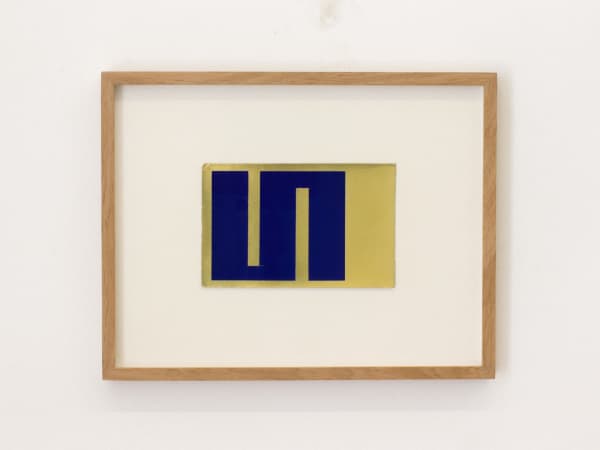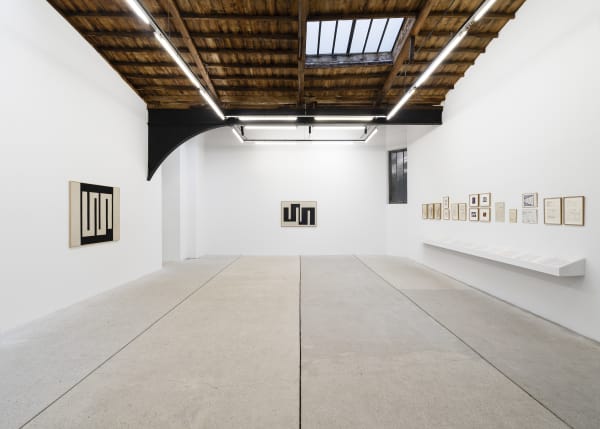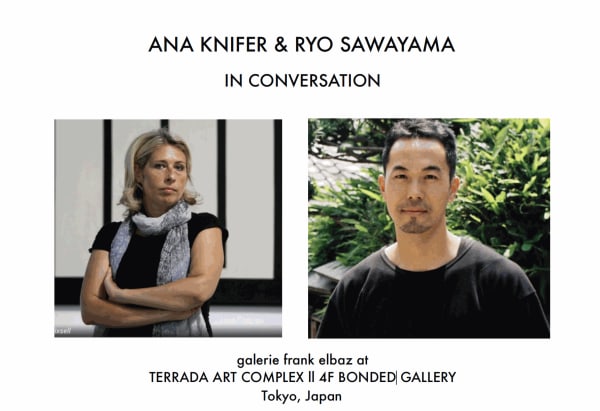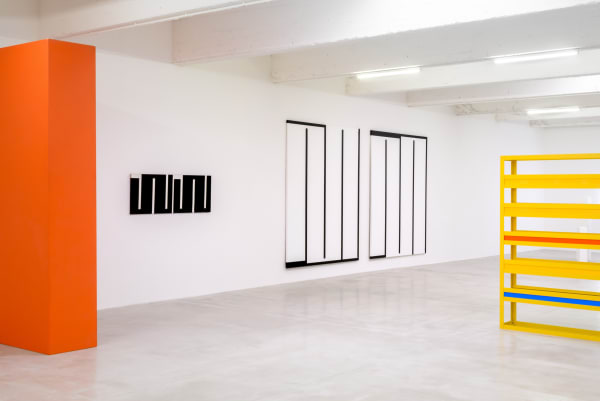Julije Knifer
Biography
Julije Knifer (born in 1924 in Osijek, Croatia ; died in 2004 in Paris)
Julije Knifer is today largely recognised as one of the most prominent Croatian painters of the 20th Century. One of the founding members of the 1960s Croatian avant-garde group Gorgona, his oeuvre is centralised over the exploration of a single form – the meander, which started in the late 1950s and later developed into the single central point of his artistic production.
The artist arrived at the meander whilst searching for the utter reduction of all expressive elements: "Within a few months I came, as it were, to the end, that is to a black and white painting (which I referred to as an anti-painting) – to a meander from which one simply cannot go any further“ (Artist quoted on www.msu.hr/en/20302) In art iconography, the winding meander of the river has been used since the earliest artistic production and is considered a synonym for the eternal flow of life; however, to Knifer the meander was a key to a world in which chronology had no meaning, and a way of creating works that were beyond their singular self, but part of a group of works that he continued to paint until the very last days of life.
Gorgona group, which Knifer co-founded, was international both in its core activities and in its ethos. Archives of the group reveal regular exchanges between Croatian artists associated with the group and their international contemporaries, including Lucio Fontana, Robert Rauschenberg and Piero Manzoni. Furthermore, François Morellet, Piero Dorazio and Victor Vasarely exhibited with Gorgona in the first exhibition of the New Tendencies movement in Zagreb in 1961.
Knifer articulated the meander conceptually in his early sketches before he formally started painting the motif, and his life-long dedication to this simple form - the study of absence, the reduction and complete perfection in execution - reveals an artist who found his meditative outlet in the process of painting. Much like On Kawara in his Date Paintings, Knifer used a singular theme in his work to record the timeless existence and repetition of the purest, simplest form, creating calmness and beauty that exudes from these works.
Knifer represented Croatia in the 2001 Venice Biennale, and in 2014 the Museum of Contemporary Art in Zagreb mounted a full retrospective of his work. He has exhibited at Centre Pompidou, Paris, MAMCO in Geneva and Museum of Contemporary Art, Sydney, and his works are in numerous private and public collections around the world, including the MOMA in New York, the Tate London, The Centre Pompidou in Paris and the National Gallery in Berlin.
Knifer represented Croatia in the 2001 Venice Biennale, and in 2014 the Museum of Contemporary Art in Zagreb mounted a full retrospective of his work. He has exhibited at Centre Pompidou, Paris, MAMCO in Geneva and Museum of Contemporary Art, Sydney, and his works are in numerous private and public collections around the world, including the MOMA in New York, the Tate London, The Centre Pompidou in Paris and the National Gallery in Berlin.
Julije Knifer (né en 1924 à Osijek, Croatie ; mort en 2004 à Paris).
L'artiste croate Julije Knifer étudia à l'Académie des Beaux-Arts de Zagreb de 1951 à 1957, sous la tutelle du professeur Duro Tiljak ; c'est là qu'il découvrit le passage de la figuration à la non-figuration, ainsi que les notions d'un « rien » et d'un « zéro » de la forme. Le Suprématisme russe, et surtout l'oeuvre de Kazimir Malevitch, eurent une très grande influence sur son travail à ses débuts. D'abord membre du groupe d'avant-garde Gorgona, il décida par la suite de se concentrer sur le méandre, une forme géométrique semblable à un labyrinthe et presque toujours réalisée en noir et blanc, qui apparut pour la première fois dans son travail en 1960 et devint presque l'unique motif de son œuvre. Le méandre est pour lui une figure dont les modulations semblent restituer le rythme d'une durée intérieure. Son œuvre inclut des peintures, des dessins (crayon et graphite sur papier) et des sculptures.
Works
Exhibitions
-

Discontinuous Lines: Julije Knifer and Kumi Sugai
TERRADA ART COMPLEX l BONDED GALLERY 4F, Tokyo, Japan 10 - 29 Apr 2025galerie frank elbaz TERRADA ART COMPLEX lI BONDED GALLERY 4F 1 Chome-32-8 Higashishinagawa Shinagawa City, Tokyo 140-0002, Japan The exhibition was conceived under the guidance of Kenjiro Okazaki. Presented in...Read more -

Julije Knifer
Le Méandre comme destin 23 Nov 2024 - 11 Jan 20252024 marks the centenary of Julije Knifer’s birth (1924–2004). Numerous exhibitions and events have been dedicated to the artist across the globe to honor this milestone. To conclude this year...Read more -

Collages: Tomislav Gotovac, Julije Knifer, Mangelos and Mladen Stilinović
curated by Branka Stipančić 29 Apr - 17 Jun 2023The links between these four artists from the Zagreb conceptual scene are different: Julije Knifer and Dimitrije Bašićević Mangelos were members of the neo-avantgarde group Gorgona (1961 – 1966); Tomislav...Read more -

Julije Knifer
3 Jun - 31 Jul 2021galerie frank elbaz is pleased to present a selection of historical works by Croatian artist Julije Knifer. 'The group of paintings gathered in this exhibition is exceptional. Firstly, because the...Read more
-

Julije Knifer
Fiac 2019 17 - 20 Oct 2019Julije Knifer is today largely recognised as one of the most prominent Croatian painters of the 20th Century. One of the founding members of the 1960s Croatian avant-garde group Gorgona,...Read more -

Julije Knifer
Mural Paintings 9 Jun - 28 Jul 2018galerie frank elbaz is pleased to announce its fifth Julije Knifer solo exhibition. This is the first exhibition in France dedicated to Julije Knifer’s mural paintings. Internationally recognized as the...Read more -

Julije Knifer
The meander is a form of my freedom 23 May - 31 Jul 2015Julije Knifer has been repeating throughout his life the same pattern, the meander. Between 1959 and 1960 he defined the basic elements of his works by reducing his pictorial means...Read more -

Gorgona
Knifer, Mangelos, Vaništa... 9 Jun - 30 Jul 2011The works making up this exhibition at Galerie Frank Elbaz spotlight a distinctive avant-garde within the Croatian and European context during the second half of the 20th century. The works...Read more
News
-

Ana Knifer & Ryo Sawayama in conversation
Saturday, April 19 at 2 PM : galerie frank elbaz at TERRADA ART COMPLEX ll 4F BONDED GALLERY Tokyo, Japan Saturday, April 19 at 2 PMSaturday, April 19 at 2 PM As part of the exhibition Discontinuous Lines: Julije Knifer and Kumi Sugai —marking the first presentation of Julije Knifer’s...Read more -

MoMA: Julije Knifer and Mangelos
MoMA, Floor 4, 406, New York, USA March 1, 2025 - March 1, 2028 Read more -

Julije Knifer
I Walk the Line (group show), Le Consortium Museum, Dijon, France January 31 – September 7, 2025 Read more -

Julije Knifer / Tomo Savić Gecan
Untitled, Apoteka, Vodnjan, Croatia June 1 - July 13, 2024 Read more
Press
-

「断続する線:ユリエ・クニファーと菅井汲」
Tokyo Art BeatMarch 25, 2025 -

断続する線:ユリエ・クニファーと菅井汲
美術手帖March 24, 2025 -

"Méandres, toboggans et Adam endormi"
The Art NewspaperPatrick Javault, December 13, 2024 -

"From Zagreb to the World: The Lasting Legacy of Julije Knifer"
The Smithsonian MagazineNovember 15, 2024
-

One Artist and One Motif: Julije Knifer and His Meander
Daily Art MagazinePetra Dragasevic, July 20, 2023 -

"Julije Knifer's Anti-paintings make a virtue of Monotony"
Art in AmericaRachel Wetzler, February 13, 2020 -

"Suivez le méandre"
Quotidien de l'ArtRafael Pic, June 11, 2018 -

"En route with Knifer"
DorotheumMartina Batovic, April 10, 2018
-

"Going global: Paris art gallery opens Dallas branch"
The Dallas Morning NewsRick Brettell, January 30, 2017 -

"Julije Knifier"
artpressEric Verhagen, September 2, 2015 -

"Julije Knifer"
ArtforumKate Sutton, March 13, 2015 -

"Des coupures personnelles dans l'art de Zagreb"
Le Quotidien de l'ArtCédric Aurelle, December 11, 2014
-

"Julije Knifer's Unstable and Expansive Geometry"
HyperallergicJohn Yau, March 15, 2014 -

Anti-peinture
TechnikartAude Launey, February 20, 2010 -

Knifer u Parizu
Elle DekorDanka Šošić, February 10, 2010 -

Pariz izlaže Kniferova djela koja Zagreb nikad nije vidio
JutarnijZvonko Maković, January 31, 2010
Events








































